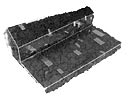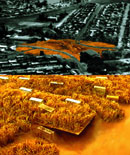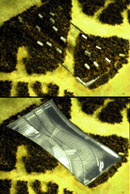
For
some years now, Roche, DSV & Sie.P have been pursuing their research
into an almost negative definition of architectural identity. "Making
with to do less" is the way they put it. Over and above any presupposition
about form and function, architecture should be defined by a set of
relations, not only to do with its contextual incorporation, but also
with a social pragmatics in which it must regain a factual value. Many
projects seem akin to installation-architecture of the moment contrasting
with the traditional architectures of inclusion and permanence. Roche,
DSV & Sie.P often contrasts modern, functional form with a parasitic
form, a non-form which seems made of humble materials - a temporary
form stemming from an assemblage, vestige of an immediately readable
human praxis. The reference to nomadism, factual constructions, shanty-towns,
and favelas refers to a culture of recycling, displacement, and makeshift
assemblages, where architecture is defined as something empirically
close to use and function. What Roche, DSV & Sie.P proposes often
clashes with a context, be it urban and well thought out, or even natural,
with its flipside, a negative part which has to be reactivated in order
to make architecture dynamic. Whence the Memorial Museum project in
Soweto, and the Sainte-Rose project or the Maïdo project, on the
island of Reunion, whose identity seems vague, to the point of becoming
altogether virtual with the invisible bloc and the rectangular section
which creates the artificial clearing of the Reunion Regional Contemporary
Art Collection [FRAC], by redistributing the functional premises at
the edge of the forest. The architecture of Roche, DSV & Sie.P is
an architecture of dérive (drift). It shrinks from any constructional
positivism. It raises issues to do with means, techniques, and the language
of a type of engineering which seems to have completely frozen the role
of project management. Here the architect regains a primary role. He
assembles, gives cohesion, reveals, and accomplishes a demand which
is capable of redefining and recontextualizing. The architecture of
Roche, DSV & Sie.P thus aims to participate in its own environment
in a twofold movement of mimesis as an inventive method, and recycling,
extraction and transformation. It does not rise up on a piece of ground,
but within a critical experiment which introduces a change of contextual
parameters. A critical experiment that Roche, DSV & Sie.P is currently
undertaking with new technologies (morphing), in order to remain open
to areas of investigation likely to introduce new parameters and prompt
"scenarios of distortion, substitution, hybridization, cloning,
grafting, and scarification". We thus have Acqua Alta, the Venetian
project which aims to "capitalize on the lagoon identity"
and which sets forth processes of "sedimentation and hybridization"
where "functions occur in many different string-like intersections,
like a PVC medusa sweeper, with murky, dense transparency" (F.
Roche).








